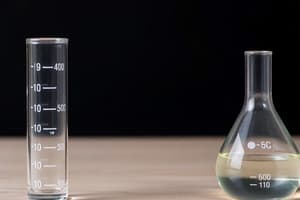Podcast
Questions and Answers
What does the rate constant in a first-order reaction represent?
What does the rate constant in a first-order reaction represent?
- Rate of disappearance/appearance (correct)
- Integrated Rate Equation
- Order of reaction
- Concentration of the reactant
What is the meaning of the term 'half-life' in the context of reactions?
What is the meaning of the term 'half-life' in the context of reactions?
- Time taken for the reaction to be completed
- Temperature at which the reaction occurs
- Initial concentration of reactants
- Time taken for the concentration to halve (correct)
In the integrated rate equation, what does 'A' represent?
In the integrated rate equation, what does 'A' represent?
- Initial concentration of reactants (correct)
- Order of the reaction
- Rate constant
- Concentration of the product
What is the order of a reaction if its rate is proportional to $[A]^2$?
What is the order of a reaction if its rate is proportional to $[A]^2$?
Which term represents the slope in a plot of $\ln[A]_t$ against time for a first-order reaction?
Which term represents the slope in a plot of $\ln[A]_t$ against time for a first-order reaction?
If two reactants have different concentrations in a reaction, what is the order of this reaction?
If two reactants have different concentrations in a reaction, what is the order of this reaction?
Flashcards are hidden until you start studying
Study Notes
Rate of Disappearance/Appearance
- The rate of disappearance/appearance is represented by -dC/dt or dC/dt, where C is the concentration of the reactant.
Integrated Rate Equation
- The integrated rate equation for a reaction is given by C = C0 * e^(-kt), where C is the concentration of the reactant at time t, C0 is the initial concentration, and k is the rate constant.
First-Order Reaction
- A first-order reaction is a reaction whose rate depends on the concentration of one reactant.
- The rate equation for a first-order reaction is given by -dC/dt = k * C.
- The integrated rate equation for a first-order reaction is given by ln(C/C0) = -kt.
- The half-life of a first-order reaction is given by t1/2 = ln(2) / k.
Second-Order Reaction
- A second-order reaction is a reaction whose rate depends on the concentration of two reactants.
- The rate equation for a second-order reaction is given by -dC/dt = k * C^2.
- The integrated rate equation for a second-order reaction is given by 1/C - 1/C0 = kt.
Zero-Order Reaction
- A zero-order reaction is a reaction whose rate does not depend on the concentration of the reactant.
- The rate equation for a zero-order reaction is given by -dC/dt = k.
Reaction with Two Reactants
- The rate equation for a reaction with two reactants A and B is given by -dC/dt = k * [A]^m * [B]^n, where [A] and [B] are the concentrations of A and B, and m and n are the orders of reaction with respect to A and B.
Half-Life
- The half-life of a reaction is the time required for the concentration of the reactant to decrease to half of its initial value.
Rate Constant
- The rate constant (k) is a constant of proportionality that relates the rate of reaction to the concentration of the reactant.
Units of Rate Constant
- The units of the rate constant depend on the order of the reaction.
- For a first-order reaction, the units of k are s^-1.
- For a second-order reaction, the units of k are M^-1s^-1.
Studying That Suits You
Use AI to generate personalized quizzes and flashcards to suit your learning preferences.



